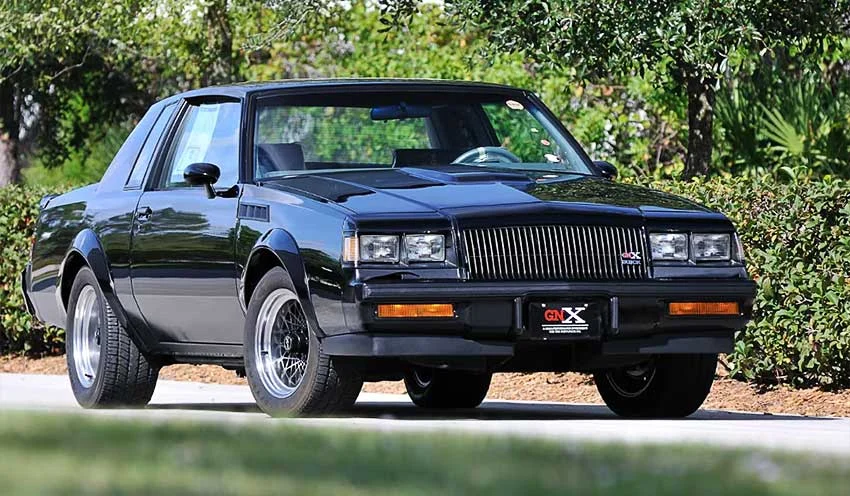The automotive world has always been fascinated by vehicles that defy expectations, and the 1987 Buick Grand National is one of the finest examples of this phenomenon. Nearly four decades after it first hit the streets, this dark, turbocharged machine continues to captivate car enthusiasts, collectors, and casual admirers alike. In an era dominated by electric vehicles, autonomous driving, and minimalist design, the Grand National remains a loud, unapologetic symbol of power and attitude. But what is it about this particular Buick that continues to turn heads in 2025? To understand that, we must revisit its roots, performance, cultural impact, and the legacy it carries today.
The Birth of a Blacked-Out Legend
The 1987 Buick Grand National was the final and most powerful iteration of Buick’s Regal-based performance series. Originally launched as a limited-edition package in 1982 to celebrate Buick’s success in NASCAR, the Grand National quickly evolved into a performance icon. By 1987, it had become a full-fledged street menace that challenged and often defeated more expensive sports cars of its time, including Corvettes, Mustangs, and even European imports.
Buick engineers took the otherwise conservative Regal and transformed it into a sinister, all-black coupe with a turbocharged V6 engine. The combination was both elegant and menacing, earning it nicknames like “Darth Vader’s Car.” The 1987 model was the pinnacle of the Grand National’s evolution, featuring a 3.8-liter turbocharged and intercooled V6 engine producing 245 horsepower and 355 lb-ft of torque. While those numbers might seem modest today, they were astonishing for the mid-1980s—especially from a Buick.
Performance That Shocked an Era
The 1987 Buick Grand National wasn’t just about looking mean; it was brutally fast. When tested new, it could sprint from 0 to 60 mph in around 4.9 seconds and complete a quarter mile in about 13.9 seconds—numbers that embarrassed many high-end performance cars of the era. What made the Grand National’s performance so thrilling was not just its speed, but the way it delivered that power. The turbocharger gave it a rush of torque that came on like a tidal wave, pressing drivers firmly into their seats.
The car’s rear-wheel-drive setup, combined with its stout automatic transmission, made it accessible even to drivers unfamiliar with high-performance vehicles. In many ways, it was America’s sleeper muscle car—a vehicle that didn’t rely on loud exhausts or flashy styling to prove its worth. Its all-black exterior and minimal chrome trim made it a stealthy powerhouse that exuded understated aggression.
A Design That Still Commands Attention
In 2025, the 1987 Buick Grand National continues to captivate onlookers with its timeless and intimidating design. The car’s glossy black paint, sharp edges, and boxy proportions perfectly encapsulate the 1980s muscle aesthetic. Unlike many cars from that era that appear dated today, the Grand National’s purposeful simplicity gives it a modern appeal. Its dark, mysterious aura stands in stark contrast to the bright colors and aerodynamic curves of today’s vehicles.
Car shows in 2025 often feature meticulously restored Grand Nationals that attract crowds of both young and old enthusiasts. Younger audiences, many of whom grew up surrounded by sleek electric cars, are drawn to its raw mechanical presence. There’s something magnetic about seeing a perfectly preserved black coupe with chrome wheels and a stance that screams authority. Even without knowing its history, one glance at the Grand National tells you it means business.
The Cultural Impact and Pop Icon Status
Beyond its performance and looks, the 1987 Buick Grand National has solidified its place in pop culture. Its appearance in movies, television shows, and music videos has cemented its reputation as the ultimate symbol of 1980s cool. Perhaps most notably, its role in “Fast & Furious” films introduced a new generation of fans to the car’s dark charisma.
The Grand National represented more than just power—it symbolized rebellion, individuality, and a challenge to the norm. At a time when Buick was known for producing luxury sedans for older buyers, the Grand National shattered expectations. It told the world that Buick could build something that not only looked menacing but could back it up on the drag strip.
Collectibility and Rising Value
In 2025, the 1987 Buick Grand National has become a prized collectible. Its value has steadily increased over the years, with pristine or low-mileage examples commanding six-figure prices at auctions. Collectors appreciate its rarity, as Buick produced fewer than 21,000 units in its final year. The most sought-after version, the 1987 GNX, was a special limited edition built in collaboration with McLaren Performance Technologies, producing an estimated 276 horsepower. Only 547 GNX models were made, and they are now among the most valuable American cars of the 1980s.
The appeal for collectors lies not only in the car’s performance but also in its historical significance. The Grand National was the last hurrah for Buick’s muscle car era before the industry shifted focus to efficiency and comfort. Owning one today is like possessing a piece of automotive rebellion—a reminder of when Buick dared to be bold.
Why It Still Matters in 2025
In today’s automotive landscape, the 1987 Buick Grand National stands as a reminder of what made cars thrilling in the first place. While modern vehicles boast impressive horsepower, instant torque, and self-driving capabilities, they often lack the visceral connection that cars like the Grand National provide. Driving one isn’t just transportation—it’s an experience. You feel the turbo spool up, hear the growl of the V6, and sense every vibration through the steering wheel.
In 2025, the car also represents a form of nostalgia for simpler times—before digital dashboards and complex software updates dominated the driving experience. For many enthusiasts, it’s a link between the mechanical past and the technological present. The Grand National continues to inspire tuners, engineers, and designers who appreciate its raw authenticity.
A Symbol of American Performance Heritage
The 1987 Buick Grand National remains a significant chapter in America’s performance history. It proved that innovation didn’t always come from the expected places. Buick, a brand known for comfort and luxury, shocked the world by building one of the fastest and most iconic cars of the 1980s. This contradiction—luxury meets muscle—gave the Grand National its enduring mystique.
Today, it represents an era when automotive manufacturers weren’t afraid to take risks. It’s a benchmark for how design, performance, and attitude can combine to create something truly timeless. In a sense, the Grand National serves as a bridge between the muscle cars of the 1960s and the high-tech performance machines of the modern era.
Conclusion
The 1987 Buick Grand National continues to turn heads in 2025 not just because of its striking looks or impressive performance, but because of what it represents. It’s a symbol of American ingenuity, a defiant statement against conformity, and a timeless example of automotive excellence. Even as electric supercars dominate headlines, the Grand National holds its ground as a cultural icon that refuses to fade into history. Its blacked-out body, turbocharged heart, and rebellious spirit ensure that every time it rolls down the street, people still stop and stare—reminded of an era when cars had personality, and driving was pure passion.


